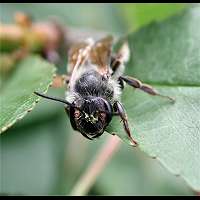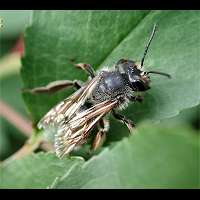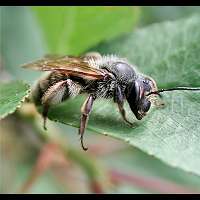Andrena carantonica
Andrena carantonica is one of the most common Mining Bees in parks and gardens. This species likes to make nests under pathways, stones and tiles. Even though there are a few similar species Andrena carantonica may often be identified by the combination of looks and the location of the nests. The female is a very dark Mining Bee. The abdomen is dark brown and almost hairless, the thorax is covered in ochreous brown hairs. The head has some ochreous hairs too, but is black mainly. She is quite similar to an ordinary Honey Bee, the latter being more slender though. Males and females differ in size. The females reach a length of 13 or 14mm, males vary in length from 10 to 13mm. This puts both genders in the league of the big Mining Bees. Males are seen at the beginning of May mainly. The females appear at the end of April, but sometimes as early as mid-March and may be on the wing to the end of June. Andrena carantonica may appear in huge numbers. Females share a common entry during nesting. Underground however each female takes care of her own chamber. Using the same entrance without being a real structured community is called communal. Because many chambers share one exit, fresh animals meet eachother in this exit while trying to get out for the first time in spring. Males try to mate immediately, so in many cases the females have been fertilized even before seeing daylight. In Dutch this Mining Bee is called the Hawthorn Bee, for Hawthorn is very popular among the bees. However Maple blossom apparently is just as popular. This species is very frequently encountered in Southern England. More scattered in Northern England and Wales. Not common, but present in Southern and Central Scotland. Very rare in Ireland.
The female in the picture could well be over 2 months old. She is so worn and has lost so many hairs, that she can not be identified with absolute certainty. However it is very likely indeed she is an Andrena carantonica.
Scientifically Andrena carantonica is also referred to as Andrena jacobi. Sometimes it is argued there are two separate species actually: Andrena jacobi being a species of early spring, on the wing in March and especially April, while Andrena carantonica is a species appearing later, which is seen in May and June mainly. There is no scientific proof of this however, so most scientists still think there is one species only. To add to the confusion Andrena carantonica is also known as Andrena scotica and Andrena sabulosa.
Andrena carantonica is one of the most common Mining Bees in parks and gardens. This species likes to make nests under pathways, stones and tiles. Even though there are a few similar species Andrena carantonica may often be identified by the combination of looks and the location of the nests. The female is a very dark Mining Bee. The abdomen is dark brown and almost hairless, the thorax is covered in ochreous brown hairs. The head has some ochreous hairs too, but is black mainly. She is quite similar to an ordinary Honey Bee, the latter being more slender though. Males and females differ in size. The females reach a length of 13 or 14mm, males vary in length from 10 to 13mm. This puts both genders in the league of the big Mining Bees. Males are seen at the beginning of May mainly. The females appear at the end of April, but sometimes as early as mid-March and may be on the wing to the end of June. Andrena carantonica may appear in huge numbers. Females share a common entry during nesting. Underground however each female takes care of her own chamber. Using the same entrance without being a real structured community is called communal. Because many chambers share one exit, fresh animals meet eachother in this exit while trying to get out for the first time in spring. Males try to mate immediately, so in many cases the females have been fertilized even before seeing daylight. In Dutch this Mining Bee is called the Hawthorn Bee, for Hawthorn is very popular among the bees. However Maple blossom apparently is just as popular. This species is very frequently encountered in Southern England. More scattered in Northern England and Wales. Not common, but present in Southern and Central Scotland. Very rare in Ireland.
The female in the picture could well be over 2 months old. She is so worn and has lost so many hairs, that she can not be identified with absolute certainty. However it is very likely indeed she is an Andrena carantonica.
Scientifically Andrena carantonica is also referred to as Andrena jacobi. Sometimes it is argued there are two separate species actually: Andrena jacobi being a species of early spring, on the wing in March and especially April, while Andrena carantonica is a species appearing later, which is seen in May and June mainly. There is no scientific proof of this however, so most scientists still think there is one species only. To add to the confusion Andrena carantonica is also known as Andrena scotica and Andrena sabulosa.






